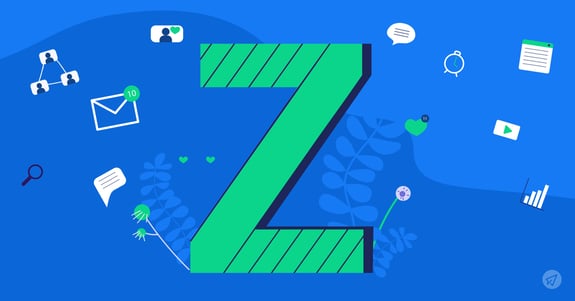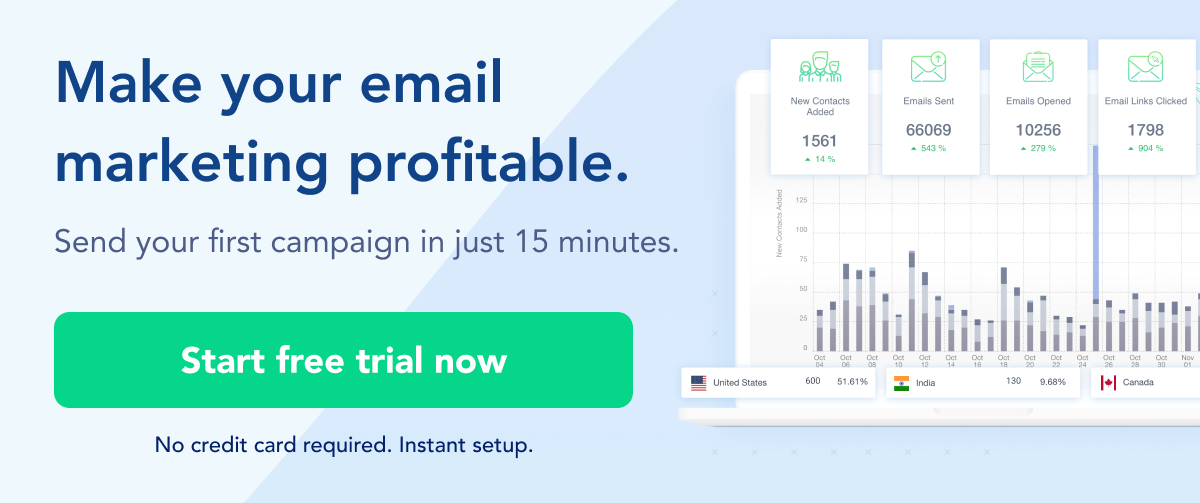Generation Z is filled with tech-savvy, native web users. This means they know a great online deal when they see one and are unlikely to be impressed by outdated email marketing tactics. They’re also a growing demographic.
Failing to appeal to Gen Z via email marketing is a serious issue if you’re trying to sell to a younger audience. Recent data from the Global Web Index (GWI) shows that 56% of Gen Z consumers prefer shopping online. This means you may miss out on revenue if you do not craft emails with Gen Z in mind.
Emails are the perfect way to convince Gen Z to buy from your brand, too. Folks who receive your emails already care about your business and will want to see high-quality, informative email content. Round this out with a few exclusive promotional offers, and you’re sure to see an uptick in interest from Gen Z consumers.
Table of Contents
Gen Z General Trends
Before you start crafting emails tailored to a younger audience, you need to do some market research and find out Gen Z’s preferences. This is crucial, as stereotypes and biases may lead you astray and alienate you from your younger readers. Instead, focus on learning more about your particular younger audience, and abide by rough Gen Z marketing guidelines like:
- Create organic content to complement your email marketing.
- Skip the hard sell and focus on building a positive brand reputation, instead.
- Amplify the good deeds your brand does and foreground the business’ values.
- Seek feedback for use in testimonials and reviews.
These general trends still require plenty of forethought and planning. For example, if you want to create more organic content for your email campaigns, you’ll likely need to gather data points like social media mentions, interactions, and common brand engagement metrics. This helps you create high-quality behavioral email marketing content that resonates with your target audience and builds a bond between your business and the Gen Z consumers who receive your emails.
Mobile Optimization
Gen Z consumers are infamous for their profound use of mobile phones. This stereotype is backed by data, too. Researchers from the GWI found that some Gen Z consumers spend up to 4 hours per day on their phones and nearly 2 hours on social media. As a marketer, this means your email campaigns must be optimized for mobile users, too.
When crafting email content, check things like:
- Subject Line Length: Will the full subject line fit on the smartphone’s mail app? If not, cut it down.
- Images: How do your images display on a smartphone? Do they look squashed or stretched when you view them in the mail app?
- Navigation: Are your buttons easy to see and big enough to tap? Will folks accidentally tap on other buttons when trying to select the navigation option they want?
- Call-to-Action (CTA): Can users see your Call-to-Action as soon as they open your email? Foregrounding your CTA ensures that every recipient sees the sale or promotion you’re currently running while they scroll through their inbox.
When assessing the effectiveness of your email campaigns, be aware that iOS 15 can skew your findings. iOS 15 prevents you from gathering an effective open rate and will simply show a 100% result when your email lands in an Apple user’s inbox. Accounting for this artificial change in open rate is key if you want to create visual content that attracts Gen Z and leads to higher conversions.
Visual Elements
Like any generation, Gen Z consumers have a palette and visual taste of their own. This means you must abide by general rules when trying to build your appeal amongst younger users. Start by reconsidering your approach to brand colors. Rather than sticking to the same boring palette, consider using color psychology to choose shades and tones that appeal to younger audiences.
Consider your brand values when using color psychology principles. For example, if you sell wellness courses, you probably want to opt for blues and yellows, which are associated with calmness and happiness. Double down on this choice by turning the saturation up, as Gen Z shows a preference for bright colors that really pop.
If you want to save time while creating content for your email campaigns, consider embedding social content into the body of your message. This will help you create a uniform brand image, too, as folks will see the same content across different channels. Embedding Instagram posts and YouTube videos helps you promote high-quality content, too. This is crucial, as Gen Z consumers want to connect with brands that share their values and sense of style.
When crafting visual content, consider creating value-driven, entertaining posts and videos rather than sales-y promotions. This will help you resonate with younger consumers who want to connect with companies that reflect their beliefs and values. Emails give you the perfect space to deep-dive on things like your mission statement and ESG policies, too, as subscribers are more likely to care about your company’s impact on the world.
Brand Perception and Data Privacy
Crafting a strong brand identity is key when marketing to Gen Z. Sending emails represents a perfect opportunity to hone in on your image and create loyal customers, too. Folks who subscribe to your emails have probably bought something from you before and will be happy to see your brand pop up in their inbox.
This means you can use your email list to improve brand loyalty and increase retention. This is crucial, as young consumers have a high lifetime value and are always looking for new brands to buy from. By personalizing your emails, you create a sense of exclusivity and improve brand loyalty. This can support your business’s long-term goals and help you capture a larger chunk of the overall market share.
However, before you start using personalized insights to create branded content, be sure to put a strong data protection plan in place. Gen Z is more aware of their digital footprint than most generations and is keen to protect themselves online. They’ll unsubscribe quickly if they believe you’re selling their data or are susceptible to a breach. You can improve consumer data privacy and protect your brand by utilizing security methods like:
- Activity monitoring: Helps prevent breaches by identifying unusual activity and alerting cybersecurity specialists quickly,
- Access control: Limits the number of people who have access to data like email lists, thus reducing the risk of an accidental breach.,
- Multi-factor authentication: Provides an extra layer of protection when logging in and is a powerful deterrent against would-be hackers.
- Data masking: This involves modifying data so it is unusable for malicious actors but still valuable to folks in your firm.
These steps will ensure your email list is properly protected and show consumers that you care about their privacy. This will help you craft a brand image based on respect and care for consumers. This is crucial, as Gen Z consumers care more about how a company operates than any other generation.
This idea is exemplified by Bo Finneman, leader of McKinsey's Marketing & Sales, who explains that Gen Z is looking “beyond tangible products and actually trying to understand what it is that makes the company tick. What’s its mission? What’s its purpose?” This highlights the importance of ensuring that your own house is in order before you start to send Gen Z consumers personalized emails based on private data.
Personalization
The recent influx of data collection apps and tools has made wide-scale personalization possible for email marketing. This is crucial if you want to appeal to Gen Z, as many younger users show a strong preference for certain types of media based on personal taste and interests. Fortunately, you can lean on well-established email personalization techniques like:
- Segmentation: Breaking down your email list to identify key demographics based on age, gender, and location.
- Personalized sender details: Sending from a real person humanizes your brand and improves your click-through rate.
- Recommendations: Personalized shopping recommendations can boost your open rate and help you sell more via emails.
- Milestone emails: Boosts brand loyalty by celebrating folks who have been a customer with you for a particular period of time or have recently hit a sales-related milestone.
- Behavior triggers: Triggers offer a great way to re-engage customers. You can customize triggers, too. This can be a real boon if you’re noticing a drop off in interest or need to improve your repeat sales metrics.
These techniques show that you care about user preferences and are keeping track of how consumers interact with your brand. This can make a world of difference if you want to build your appeal amongst a new, younger audience and need to tweak your offering to build brand buy-in. Personalizing your email marketing can help you improve other areas of your operations, too, as personalization requires a robust data collection program that will generate useful insights for other departments.
You can also offer tiered subscriptions to folks on your email list. This further enhances brand loyalty and can add a reliable revenue stream to your firm. If the idea of personalized subscription-based offers sounds appealing, consider signing up for a service like Patreon or Substack where you can speak directly to subscribers and offer high-quality personalized content.
Personalized email marketing campaigns can improve retention, too. Over time, you can use your email marketing metrics to spot consumers about to hit “unsubscribe” and send enticing deals and promotional offers to keep them engaged. This is crucial in today's highly competitive digital marketing industry, where every business is vying for the attention of young consumers.
Conclusion
Marketing towards Gen Z can be tricky. They’re savvy web users who will hit the “unsubscribe” button quickly if your email content isn’t up to scratch. Get started with simple steps, like altering your color palette, to build your appeal and connect with younger users. Experiment with data-driven insights over time and use metrics like engagement to create personalized recommendations. This will help you attract Gen Z consumers and improve your email marketing conversion rate.



